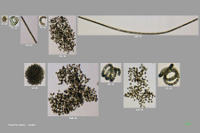The U.S. Army Corps of Engineers has contracted with water quality instrumentation manufacturer Fluid Imaging Technologies of Yarmouth, ME, for the company's automated FlowCAM® particle imaging and analysis system.
To be deployed in the Huntington District, Huntington, West Virginia, the FlowCAM will speed the detection and identification of Cyanobacteria and other algal cells in source water and permit advisories to be issued to the public more quickly than possible when using manual microscopy. (Pictured right, algal cells as imaged on the FlowCAM.)

Faster Information Protects the Public
The Huntington District Corps of Engineers manages 311 navigable miles of the Ohio River in West Virginia, Kentucky, and Ohio, plus 9 major tributaries, and operates 35 multipurpose reservoirs that provide drinking water to the region. While the large majority of these reservoirs have never experienced toxin-producing algal blooms, an increasing awareness of harmful algal blooms and their role in public safety were factors in the purchase, according to Jonathan Dawson, sales manager, municipal market for Fluid Imaging Technologies.
The FlowCAM automatically detects, images, measures, and identifies thousands of individual particles and microorganisms in a sample in seconds and saves the images and data for analysis.
"Using a microscope typically requires at least a week after sampling to document the presence of algal cells and a trained phycologist to identify the species, provide a count, and determine if advisories are needed," says Dawson. "If that knowledge can be provided faster, then the water quality department will be in a better position to provide information to the public."
FlowCAM customers include the U.S. Food and Drug Administration (FDA), U.S. EPA, U.S. Naval Research Labs, New York City Department of Environmental Protection, The Bureau of Reclamation and Massachusetts Water Resource Authority, among many others worldwide.





